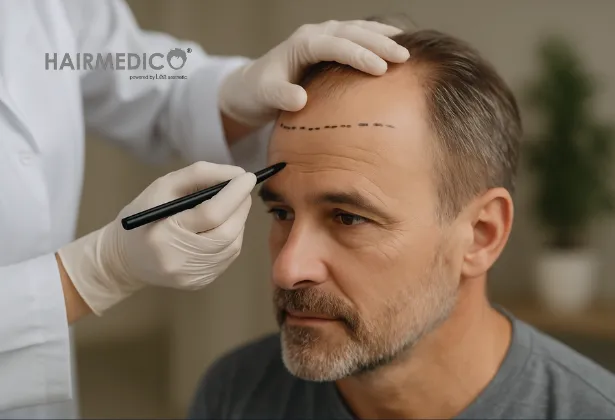
Hair transplant surgery has evolved into a highly advanced, safe, and reliable medical procedure. However, one question continues to be asked more than any other:
“What is the best age to get a hair transplant?”
Although hair loss can begin as early as the teenage years, the ideal age for a hair transplant depends on the stability of hair loss, donor area maturity, the Norwood scale stage, genetics, and long-term planning.
This comprehensive guide explains:
The ideal age range for hair transplantation
Why age matters more than graft numbers
When early surgery becomes risky
How donor area quality and genetics shape the decision
Differences between men and women
Expert recommendations from top surgeons
Long-term strategies to protect the results
This guide reflects global medical standards and the expertise of leading surgeons.
Hair loss is a progressive condition. It evolves over time and does not stabilize until later stages of adulthood. The best surgical results occur when the surgeon can accurately predict future hair loss patterns.
Below is a general overview of how hair loss typically progresses:
Early thinning may begin
Norwood stage often unclear
Hair loss is unstable and highly unpredictable
Surgery is not recommended
Norwood stage becomes more defined
DHT sensitivity increases
Crown and hairline begin to recede
Hair transplant only recommended in special cases
Genetics become clearer
Hairline pattern becomes predictable
This is where the majority of patients become eligible
Hair loss stabilizes
Norwood stage becomes highly predictable
Donor area is fully matured
Considered the optimal age range for long-term success
Hair loss progression slows
Great candidates for density restoration
Results can still be excellent
Within this range, the patient typically has:
A stable hair loss pattern
A mature donor area
Predictable Norwood progression
Strong graft survival
Long-term realistic expectations
However, there is no “one-size-fits-all” age.
Each individual’s genetic pattern, medical history, lifestyle, and donor quality influence timing.
The most critical factor is predictability.
Operating too early—especially before age 25—may result in:
Patchy future balding
Unnatural hairline after future hair loss
Donor depletion
Need for repeat surgeries
By the age of 25–30:
Follicle density is fully developed
Hair thickness is stable
Graft survival rate is higher
A hair transplant is a permanent change.
Patients must be emotionally prepared for:
Realistic expectations
Gradual hair growth over 12–18 months
Possible medical therapy (finasteride/minoxidil)
In 95% of cases, YES.
Reasons:
Hair loss is highly unstable at this age
DHT patterns not yet established
Risk of aggressive future balding
Early hairline work can look unnatural later
Exception:
Only in cases of trauma, burns, or scarring alopecia.
Absolutely not.
Many patients in their 40s and 50s achieve excellent results because:
Hair loss has stabilized
Donor density remains strong
Expectations are realistic
Procedure can focus on density instead of redesigning the entire hairline
Patients up to 65+ can still be candidates if donor quality is good.
Male pattern baldness follows the Norwood scale.
The ideal timing:
Acceptable: 20–25 (case by case)
Excellent: 30–45
Still strong: 45–55
Possible: 55+ depending on donor area**
Female pattern hair loss is often diffuse (Ludwig scale).
Most suitable ages: 30–55.
Younger women require:
Hormonal evaluation
Dermatological assessment
Stability confirmation
Minoxidil
PRP
Lifestyle regulation
No surgery unless special case
Medical stabilization (Finasteride/Minoxidil)
Preventive PRP
Ideal time for hairline restoration
Combine surgery + medical maintenance
Crown restoration becomes predictable
Density restoration
Lower need for medical therapy
Over-lowered juvenile hairline
Running out of donor grafts
Multiple revision surgeries
Unnatural appearance decades later
Accelerated future hair loss due to imbalance
A professional surgeon evaluates:
Norwood stage
Donor density
Family history
Age of onset
Hairline recession pattern
Rate of hair loss
Scalp health
Medical conditions
Lifestyle factors
Only a holistic medical evaluation can determine the correct timing.
1. What is the youngest safe age for a hair transplant?
Typically 25+, unless medically necessary.
2. What if I am losing hair rapidly at 23?
You need medical stabilization first, not surgery.
3. Is 50 too late?
Not at all. Many patients 50–60 achieve excellent results.
4. Should I start with medication before surgery?
Yes. Stabilizing hair loss improves long-term results.
5. Why do some clinics operate on 18–20 year olds?
Due to lack of ethical medical standards.
A reputable surgeon will refuse early cases.
Dr. Arslan Musbeh, internationally recognized hair transplant surgeon in Turkey, and founder of Hairmedico, has over 17 years of experience specializing in FUE, Sapphire FUE, DHI, and advanced hair restoration.
He works exclusively on a one-patient-per-day VIP model, ensuring maximal surgical precision and personalized care.
As a lecturer at Claude Bernard University Lyon 1 for the DU Traitement de la Calvitie program and frequent speaker at international medical congresses, Dr. Musbeh combines scientific expertise and aesthetic artistry to deliver world-class, natural, and permanent results.